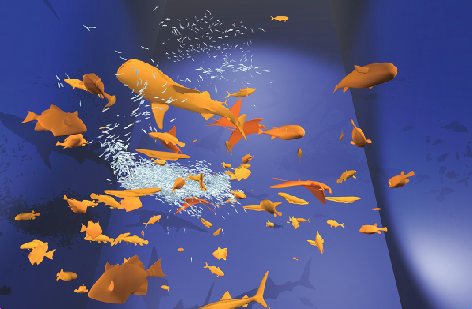
-
Unified Motion Planner for Fishes
-
We propose a unified motion planner that generates variations in fish swimming styles. By modeling the common decision-making mechanism in fish that allows them to instantly decide “where and how to swim”, we demonstrate 12 types of fishes and massive fish school with completely different sizes and skeletal structures.
- ACM Transactions on Graphics (SIGGRAPH 2016 Technical Papers)
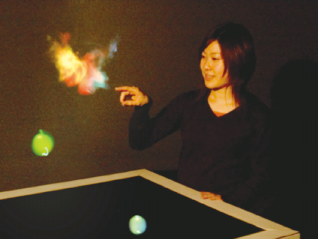
-
bubble cosmos
-
bubble cosmos is a system that creates new enjoyment by expanding soap bubble play with video and audio media. The location and size of soap bubbles floating in the air is detected, and video is projected onto white smoke injected into the soap bubbles. When it judges that a bubble has popped, changes are made to the video and sound.
- L'Oreal Art & Science Prize (2006)
- Winning 2006 ASIA DIGITAL ART AWARD (2006)
- Won the International collegiate Virtual Reality Contest (2005)
- Japan Media Arts Festival Jury Recommended Works (2006)
- SIGGRAPH Emerging Technologies (2006)
- ACE (2006)
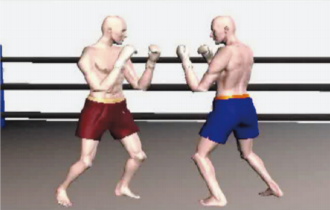
-
The Fighting Game Character that Grows up by Imitation Learning
-
This system can analyze the movement patterns of computer operated characters in fighting action games, and by partially imitating them it can create computer characters that grow with each match.
- The Journal of the Information Processing Society of Japan (2008)
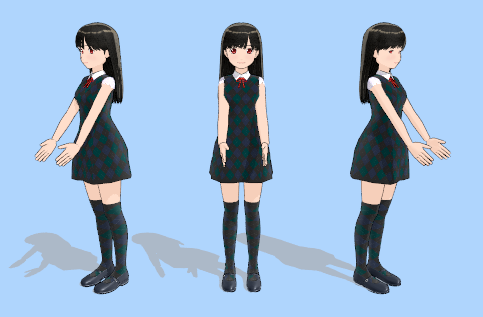
-
Reha Controller
-
This is a rehabilitation game system for elderly using the game controller that recognize the movement of the upper limb. A patient uses the game controller that detects arm movements and finger pressure from sensors, and plays the rehabilitation game by following the instructor displayed on the monitor.
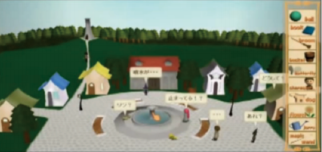
-
Spilant World
-
Spilant World is an entertainment system where you can watch the lives of characters from the world of animation, and enjoy changing their stories by working on them in real time. The episodes are expressed as the flow of events in a tree structure; the linked episodes give rise to the production of creative stories.
- Award of the Journal of the Society for Art and Science (2007)
- Award of excellence of digital cinema sector of the Society for Art and Science Exhibition (2007)
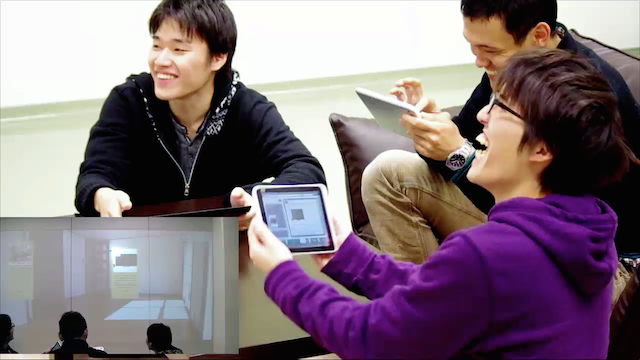
-
Cyber Chamber
-
Cyber Chamber is a system that allows multiple people to conduct online shopping through the interaction between projections on a wall from a projector and a tablet. By searching for products on the tablet and projecting them on the wall, you can smoothly conduct activities such as sharing information, consulting with collaborative buyers, and considering combining products with each other.
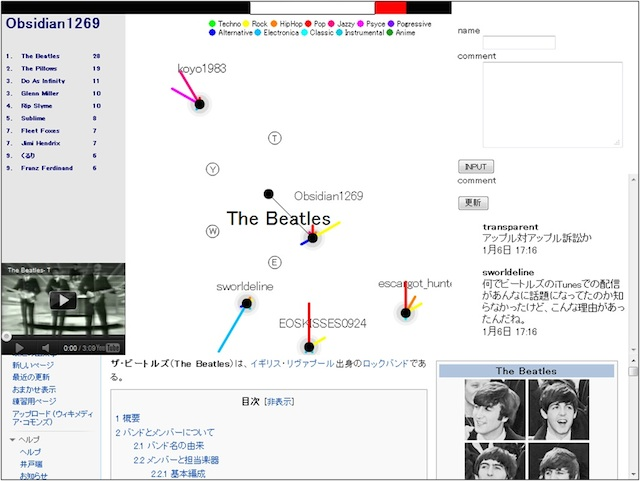
-
SONAR
-
SONAR is a social media that supports the acquisition of conversational niche hobby-related information and deepens exchange, by displaying personal hobbies and tastes graphically. Similarities with other users’ interests, and their degree, as well as the relevancy of the span of knowledge centered on the objects of the user’s interest are displayed graphically.
- The Journal of Japan Society of Kansei Engineering (2014)
- ICEC (2014)
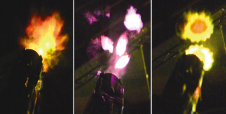
-
Hanasui
-
Hanasui is a virtual handheld firework system. A fog screen is created by fog from the device, and an image is projected onto it. By using markers, near infra-red, and multi-projections, a fog screen is created that can move and be viewed from multiple viewpoints.
- Award of Meywa Denki President of the International collegiate Virtual Reality Contest (2013)
- Transactions of the Virtual Reality Society of Japan (2014)
- ICEC (2014)
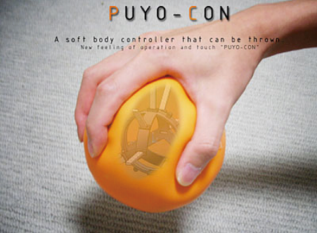
-
PUYO-CON
-
PUYO-CON is a body-sensation type game controller made of flexible soft materials that can create input based on movements such as gripping and throwing. With 40 bending sensors that sense shape changes, it sends continuous signals to the console via Bluetooth, and it is possible to have input based on the strength of the shape change, as well as tactile operations.
- IEEE International Symposium of Virtual Reality Innovation (2011)
- SIGGRAPH Emerging Technologies (2009)
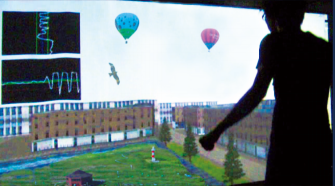
-
VR Trampoline
-
This is an entertainment system that amplifies the enjoyment of the trampoline, which has proven highly effective for exercise. Through images from the user's perspective that are connected to the exercise, and a virtual reality environment drawn with computer graphics, you can have experiences looking out into wide spaces that would be difficult to experience in reality.
- Transactions of the Virtual Reality Society of Japan (2010)
- SIGGRAPH Emerging Technologies (2009)
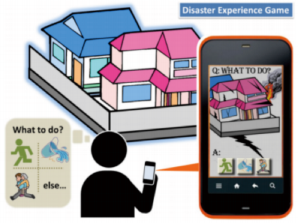
-
DEG (Disaster Experience Game)
-
Using the GPS and accelerometer in a smartphone, this system allows the user to experience various disaster events as game elements while actually walking through an area. You can have fun while learning about the ways to ameliorate disaster risks unique to an area.
- The Journal of the Information Processing Society of Japan (2013)
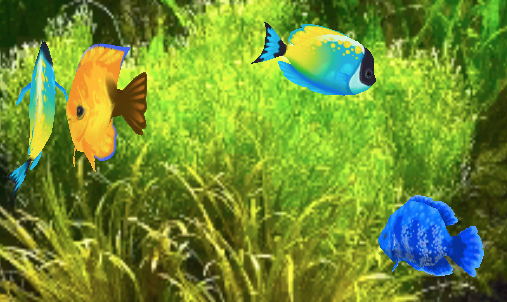
-
Animacy Motion Engine
-
Based on cognitive psychology’s animacy perception and ecophysiology, lifelike computer generated animation with the randomness and variety actually seen in the movements of living organisms is created in real time. By modeling artificial lives based on this system, tropical fishes and fireflies move autonomously, and you can create a virtual aquarium where you can feed and interact with them.
- Transactions of the Virtual Reality Society of Japan (2013)
- ICEC (2013)
- IASDR (2013)
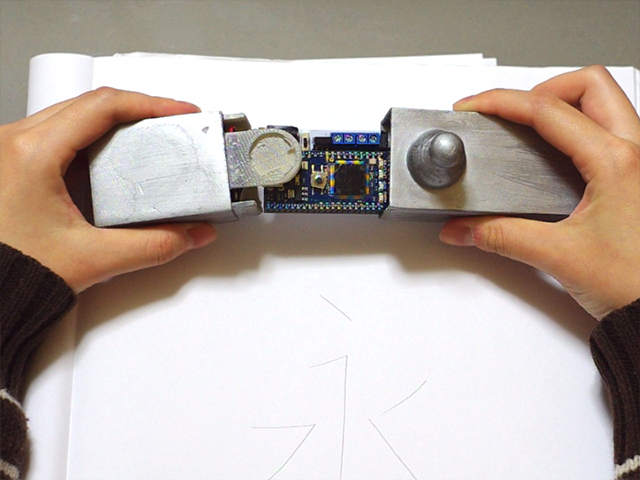
-
iBunchin
-
iBunchin is a paperweight-type device that make hand writing fun by playing sound effects synchronized with writing. When you take a note, iBunchin recognize a type of brush-strokes (“stop”, “hook” or “fade”) in real-time, and play the cute sound effect corresponding to them.
- Akizuki Award of Gugen2013 (2013)
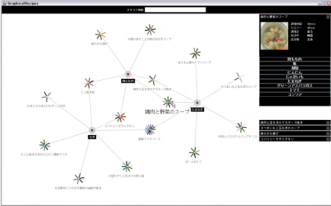
-
Graphical Recipes
-
This system visualizes the recipe search process as a graph with nodes that are individual ingredients (user-input search elements) and recipes (search results). You can conduct the entire search process leading to a satisfying recipe without switching screens.
- The Journal of the Society for Art and Science (2008)
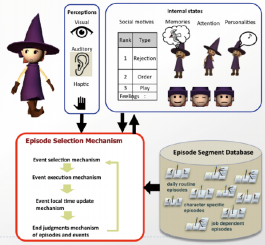
-
MACS (Massive Action Control System)
-
MACS is a character control system that allows you to continue to operate even if there is interference in real time, by setting the character’s own internal characteristics such as motivation for actions and emotions, as well as external characteristics such as objects around the character as starting conditions, and by continuously selecting fragmented behavior control modules.
- SIGGRAPH Posters (2009)
- SIGGRAPH Emerging Technologies (2009)
- ICEC (2010)
- Entertainment Computing Journal (2010)
- Award of excellence of the International CG Award of the Society for Art and Science (2009)














